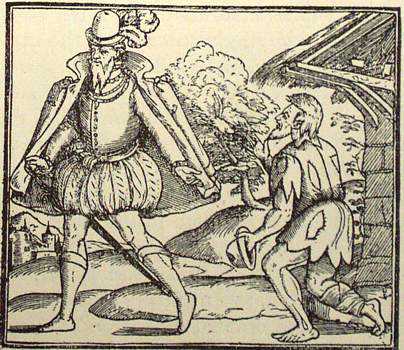Begging and vagrancy
Largely because of land enclosures, there was a large, shifting population of unemployed men and women throughout the country, especially in London.
"Masterless men" were seen as a serious threat to the stability of society. They had no place in the ideal order, and in the practical order of things they were likely to commit crime to stay alive.
Many soldiers returned from fighting overseas injured and unable to work. Inevitably they became beggars on crutches, of the kind illustrated on the following pages.
The economy
The beginning of Elizabeth's reign was favored by a largely healthy economy, but by the last decade of her reign the economy declined. As a result, crime and vagrancy became a great concern of the state. Poor harvests combined with outbreaks of the plague and influenza caused agricultural prices to climb while wages dropped to a level not seen for three hundred and forty years. Approximately four fifths of England's population of four million fell below the subsistence level. While many people were forced to rely on the help of the Church in the form of parish relief, government aid was meager, and existing laws and institutions proved insufficient to the task of dealing with the poor.
In the detail of his painting The Fight Between Carnival and Lent, the Dutch painter Pieter Bruegel captures the pain of those crippled by disease, poverty and war.
Footnotes
-
The rural poor
The rural poor consisted mainly of widows -- who simply did not have the means to support themselves -- and landless laborers, who often found themselves unemployed in the winter when their services were not required.
Local eccentrics were often also tolerated and supported by their immediate parish-community, at least in times of relative economic prosperity. On the other hand, vagrants who were passing through were likely to be either ignored or persecuted for fear that they might commit crime, or squander the charity of the community.
-
The urban poor
The number of urban poor had been increasing before Elizabeth's reign, and kept increasing during it. Even during relatively prosperous times, downward social mobility caused by population growth and the trend towards the enclosure of farm land, compelled many individuals to turn to begging for their livelihood.
-
The perception of the poor
Especially in urban settings the poor were seen as a public nuisance, a potential threat to public welfare, and, particularly in times of economic crisis, as a burden on the greater community. Local authorities often tried to curb the practice of begging, and discouraged the establishing of tenements -- houses divided into many small suites to be rented to poor individuals or families.
